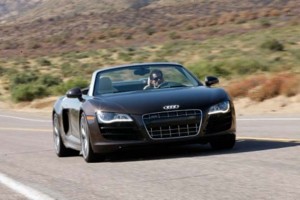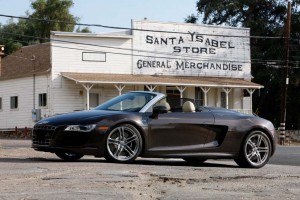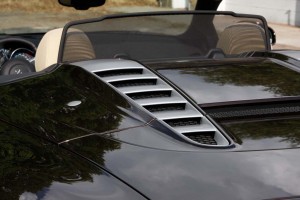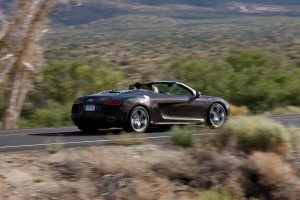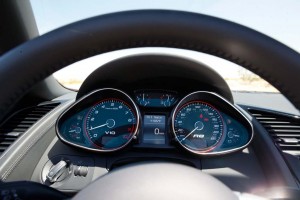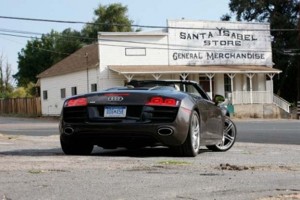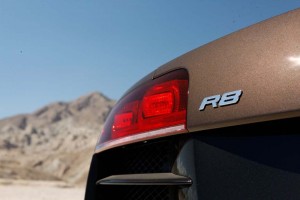For anyone who has wanted to experience the raw G-force crush of a launch from a Navy aircraft carrier. You can either enlist or start saving your pennies for the all-new 2011 Audi R8 Spyder.
If the name sounds familiar, that’s because it’s the new ragtop version of the R8 coupe, which has created a huge buzz since its launch, a couple years back. The convertible is likely to become the top-seller in the line-up, and for good reason.
The Spyder features the same 5.2-liter direct-injection V10 that Audi introduced for the R8, last year, a 528-horsepower, 391 lb-ft monster that can quite literally take your breath away when you slam the pedal down to the floor. In coupe form, it’s rated to hit 197 mph; surprisingly, the convertible cuts that top speed only by 2 mph.
(Click Here to read TheDetroitBureau.com’s review of the Audi R8 V10 Coupe.)
The surprisingly light and exceedingly nimble R8 undergoes a few visual tweaks as it reemerges in convertible form, (though the overall shape is familiar, including the distinctive LED running lights, 24 of them to represent the German marque’s ongoing dominance of the 24 Hours of Le Mans race).
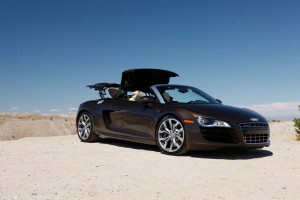
The canvas drop-top on the Audi R8 Spyder takes less than 19 seconds to open or close and operates at speeds up to 31 mph.
There is, of course, the color-coordinated top – which can be operated while moving at speeds up to 31 mph and opens or closes in just 19 seconds, a blessing, we discovered, when we ran into a freak rainstorm in the high desert outside San Diego.
Perhaps the biggest surprise was Audi’s decision to eliminate the “blade,” the strikingly distinctive carbon fiber panel behind the doors of the coupe. There also have been some revisions to the panels over the engine compartment, notably with the use of the new brightwork louvers.
The convertible gets a removable windscreen that proved surprisingly effective at eliminating buffeting at speeds well into triple digits. There’s also a power rear glass that can be operated with the touch of a button on the center console. Acoustically laminated, it can be put up to reduce engine noise. We imagine most folks will leave it down as it was uncannily efficient at blocking the roar of the big V10.
The top occupies the storage space behind the driver, found on the coupe R8, leaving only the “trunk” in the R8 Spyder’s nose. It’s cramped but functional, barely big enough to hold a roll-aboard suitcase. Beyond that, there are few sacrifices to deal with in the convertible. It’s surprisingly quiet, even at, ahem, extra-legal speeds, unless you’re revving that big V10.
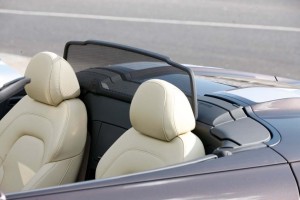
The windscreen reduces buffeting, while a power backglass cuts a surprising amount of road and engine noise.
Audi engineers even came up with an ingenious noise-canceling button microphone system, woven into the driver’s shoulder belt, which allows you to use the Bluetooth hands-free phone system with the top down at 80 mph.
Virtually everything about the R8, coupe or convertible, is an engineering tour de force. The chassis is the latest version of Audi’s increasingly familiar aluminum spaceframe technology, though the use of some key carbon fiber elements helps reduce weight and maintain the 43/57 front/rear weight distribution that Audi developers felt was the best balance for both versions of the R8.
Last year’s launch of the 5.2-liter V10 was a big improvement over the original Audi R8’s V8 powerplant. It’s by no means the most powerful engine on the block. We’ve come to think of 600 hp as almost routine, these days. But in this low, sleek, lightweight and extremely aerodynamic platform, it’s more than we have a right to ask for. The astounding 8700 RPM redline hints at the fact that the V10 is an only slightly revised version of Audi’s race motor.
Step into the throttle and you’ll hit 60 in about 4 seconds flat, but then the V10 just keeps pulling and pulling and pulling, like the Eveready roadster.
The manual gearbox is precisely what you’d expect from Audi, smooth and efficient. We were reluctant, at first, to start our day’s drive in a deep metallic brown R8 Spyder equipped with Audi’s R tronic gearbox but decided to give it another chance.
Our original experience with this electronically-shifted manual gearbox – in the R8 Coupe – was less than satisfying. Like most single-clutch designs, it bucked and balked enough to shake our fillings loose. At speed, shifts could slam you around like a battering ram. But we were advised by Audi’s Chas Murphy that the automaker made some software changes to the system, about a year after the R8 V10 Coupe’s launch, and decided to give the R tronic a second chance.
We were soon glad we did. The updated gearbox was significantly smoother and far more intuitive under almost all driving conditions, though it would occasionally hold a gear too long during in-town driving.
On the open road, we recommend going into Sport Mode, which reduces the impact of the various traction and stability intervention systems – and which will tell the R tronic, among other things, to hold your gear in a corner. The paddle shifters, meanwhile, work as well as intended.
Blasting through the open California countryside, the all-wheel-drive Audi R8 Spyder proved as nimble as the coupe, effortlessly taking marked 30 mph corners at well over twice that speed. And when we hit an open stretch and gave it throttle, we were quickly pressed deep into the well-padded sport seat, the speedometer spinning up towards triple digits.
The Audi magnetic ride system is one of the keys to the R8’s handling. It uses an unusual magneto-rheological fluid, a liquid that’s highly sensitive to magnetic fields, and which can instantly vary the response of the shock absorbers. Taking its cue from an assortment of road and vehicle sensors, the system can firm up the car’s corners in a fraction of a heartbeat.
Many high-performance drivers disdain all-wheel-drive, most systems tending to resist as you try to turn a car through turns. The R8 AWD system is one of the best out there, and generally makes the Spyder feel more like a rear-driver, with 85% of torque going to the back wheels. But under the right circumstances, as much as 35% of that power will be redirected up front.
Should it matter, you’ll get 12 mpg around town, with the manual gearbox, 19 on the highway, while the R tronic delivers 13/19.
You’ll be able to get into a 2011 Audi R8 Spyder for $161,000 plus destination charges and taxes, though the various options will get you up closer to $180,000 almost as fast as the 2-seater can hit 60.
The Audi R8 has been one of the most intriguing and attractive sports cars on the road, and with the launch of the R8 Spyder, the appeal is only enhanced. Sadly, Audi says it can only produce about 1,000 of the largely hand-built convertibles annually. They’re likely to go fast – quite literally.

